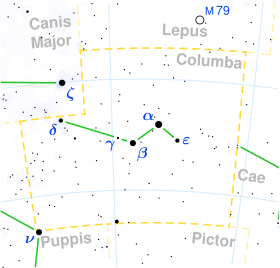Mu Columbae
Mu Columbae (μ Col, μ Columbae) is a star in the constellation of Columba. It is one of the few O-class stars that are visible to the unaided eye.[7] The star is known to lie approximately 1,300 light years from the Solar System (with an error margin of a few hundred light years).
 | |
| Observation data Epoch J2000 Equinox J2000 | |
|---|---|
| Constellation | Columba |
| Right ascension | 05h 45m 59.89496s[1] |
| Declination | −32° 18′ 23.1630″[1] |
| Apparent magnitude (V) | 5.18[2] |
| Characteristics | |
| Spectral type | O9.5 V[3] |
| U−B color index | −1.06[2] |
| B−V color index | −0.28[2] |
| Variable type | Suspected[4] |
| Astrometry | |
| Radial velocity (Rv) | +109.00 ± 1.8[5] km/s |
| Proper motion (μ) | RA: 2.98[1] mas/yr Dec.: −22.24[1] mas/yr |
| Parallax (π) | 2.52 ± 0.55[1] mas |
| Distance | approx. 1,300 ly (approx. 400 pc) |
| Absolute magnitude (MV) | −3.64[6] |
| Details[6] | |
| Mass | 16 M☉ |
| Radius | 6.58 R☉ |
| Luminosity | 45,700 L☉ |
| Surface gravity (log g) | 4.0 cgs |
| Temperature | 33,000 K |
| Rotational velocity (v sin i) | 111 km/s |
| Age | 2 - 4 Myr |
| Other designations | |
| Database references | |
| SIMBAD | data |
This is a relatively fast rotating star that completes a full revolution approximately every 1.5 days. (Compare this to the Sun, which at only 22 percent of this star's diameter rotates only once every 25.4 days.) This rate of rotation is fairly typical for stars of this class.
Based on measurements of proper motion and radial velocity, astronomers know that this star and AE Aurigae are moving away from each other at a relative velocity of over 200 km/s. Their common point of origin intersects with Iota Orionis in the Trapezium cluster, some two and half million years in the past. The most likely scenario that could have created these runaway stars is a collision between two binary star systems, with the stars being ejected along different trajectories radial to the point of intersection.[8]
Etymology
In Chinese astronomy, Mu Columbae is called 屎, Pinyin: Shǐ, meaning "Excrement" or "The Secretions", because this star is marking itself and stand alone in the asterism of the same name within the Three Stars mansion.[9][10]
References
- Van Leeuwen, F. (2007). "Validation of the new Hipparcos reduction". Astronomy and Astrophysics. 474 (2): 653. arXiv:0708.1752. Bibcode:2007A&A...474..653V. doi:10.1051/0004-6361:20078357.
- Ducati, J. R. (2002). "VizieR Online Data Catalog: Catalogue of Stellar Photometry in Johnson's 11-color system". CDS/ADC Collection of Electronic Catalogues. 2237. Bibcode:2002yCat.2237....0D.
- Sota, A.; Maíz Apellániz, J.; Morrell, N. I.; Barbá, R. H.; Walborn, N. R.; Gamen, R. C.; Arias, J. I.; Alfaro, E. J. (2014). "The Galactic O-Star Spectroscopic Survey (GOSSS). II. Bright Southern Stars". The Astrophysical Journal Supplement. 211: 10. arXiv:1312.6222. Bibcode:2014ApJS..211...10S. doi:10.1088/0067-0049/211/1/10.
- Samus, N. N.; Durlevich, O. V.; et al. (2009). "VizieR Online Data Catalog: General Catalogue of Variable Stars (Samus+ 2007-2013)". VizieR On-line Data Catalog: B/gcvs. Originally Published in: 2009yCat....102025S. 1. Bibcode:2009yCat....102025S.
- Gontcharov, G. A. (2006). "Pulkovo Compilation of Radial Velocities for 35 495 Hipparcos stars in a common system". Astronomy Letters. 32 (11): 759. arXiv:1606.08053. Bibcode:2006AstL...32..759G. doi:10.1134/S1063773706110065.
- Martins, F.; Schaerer, D.; Hillier, D. J.; Meynadier, F.; Heydari-Malayeri, M.; Walborn, N. R. (2005). "On stars with weak winds: The Galactic case". Astronomy and Astrophysics. 441 (2): 735. arXiv:astro-ph/0507278. Bibcode:2005A&A...441..735M. doi:10.1051/0004-6361:20052927.
- Walker, Richard (2017), Spectral Atlas for Amateur Astronomers: A Guide to the Spectra of Astronomical Objects and Terrestrial Light Sources, Cambridge University Press, p. 23, ISBN 1316738760
- Gualandris, Alessia; Portegies Zwart, Simon; Eggleton, Peter P. (2004). "N-body simulations of stars escaping from the Orion nebula". Monthly Notices of the Royal Astronomical Society. 350 (2): 615. arXiv:astro-ph/0401451. Bibcode:2004MNRAS.350..615G. doi:10.1111/j.1365-2966.2004.07673.x.
- (in Chinese) AEEA (Activities of Exhibition and Education in Astronomy) 天文教育資訊網 2006 年 7 月 15 日
- Richard Hinckley Allen: Star Names — Their Lore and Meaning: Columbae
Further reading
- Blaauw, A.; Morgan, W. W. (1954). "The Space Motions of AE Aurigae and μ Columbae with Respect to the Orion Nebula". Astrophysical Journal. 119: 625. Bibcode:1954ApJ...119..625B. doi:10.1086/145866.
- Hoogerwerf, R.; De Bruijne, J. H. J.; De Zeeuw, P. T. (2001). "On the origin of the O and B-type stars with high velocities. II. Runaway stars and pulsars ejected from the nearby young stellar groups". Astronomy and Astrophysics. 365 (2): 49. arXiv:astro-ph/0010057. Bibcode:2001A&A...365...49H. doi:10.1051/0004-6361:20000014.